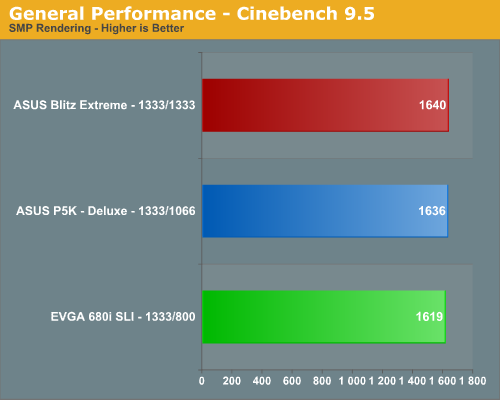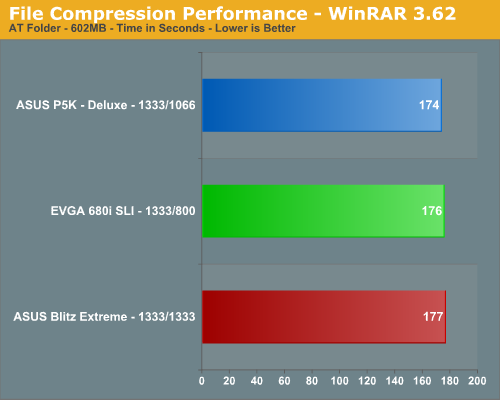NVIDIA 680i SLI: Official 1333MHz FSB CPU Support Arrives
by Gary Key on July 20, 2007 12:01 AM EST- Posted in
- CPUs
Media Encoding Performance:
Our first series of tests is quite easy - we take our original Office Space DVD and use AnyDVD and Nero Recode 2 to copy the full DVD to the hard drive without compression, thus providing an almost exact duplicate of the DVD. We then fired up Nero Recode 2, selected our Office Space copy on the hard drive, and performed a shrink operation to allow the entire movie along with extras to fit on a single 4.5GB DVD disc. We left all options on their defaults except we checked off the advanced analysis option. The scores reported include the full encoding process and is represented in seconds, with lower numbers providing better performance.

The Nero Recode Shrink results show the improved CPU throughput speeds of the Intel P35 boards resulting in a 2% advantage over the EVGA 680i SLI board.
Rendering Performance:
We are using the Cinebench 9.5 benchmark as it tends to heavily stress the CPU subsystem while performing graphics modeling and rendering. Cinebench 9.5 features two different benchmarks with one test utilizing a single core and the second test showcasing the power of multiple cores in rendering the benchmark image. We utilize the standard multiple core benchmark demo and default settings.

Once again, we notice the advantage of an Intel chipset in a CPU throughput test with the P35 placing 1% ahead of the EVGA 680i SLI board. In the grand scheme of things, this difference and the one in our Nero test is actually very minor.
File Compression Performance:
In order to save space on our hard drives and ensure we had another CPU crunching utility, we will be reporting our file compression results with the latest version of WinRAR that fully supports multithreaded operations and should be of particular interest for those users with dual core or multi-processor systems. Our series of file compression tests utilizes WinRAR 3.62 to compress our test folder that contains 444 files, ten subfolders, and 602MB worth of data. All default settings are utilized in WinRAR along with our hard drive being defragmented before each test.

In this test that stresses overall memory latencies and CPU/Memory throughput we see the DDR3 configuration finishing last. The nature of file compression is such that memory is accessed almost constantly in a very random fashion, so page misses requiring additional time as memory banks are swapped is common. The 680i did not perform as bad as we originally thought it would in this test considering its memory speed although latencies are decent.
Our first series of tests is quite easy - we take our original Office Space DVD and use AnyDVD and Nero Recode 2 to copy the full DVD to the hard drive without compression, thus providing an almost exact duplicate of the DVD. We then fired up Nero Recode 2, selected our Office Space copy on the hard drive, and performed a shrink operation to allow the entire movie along with extras to fit on a single 4.5GB DVD disc. We left all options on their defaults except we checked off the advanced analysis option. The scores reported include the full encoding process and is represented in seconds, with lower numbers providing better performance.

The Nero Recode Shrink results show the improved CPU throughput speeds of the Intel P35 boards resulting in a 2% advantage over the EVGA 680i SLI board.
Rendering Performance:
We are using the Cinebench 9.5 benchmark as it tends to heavily stress the CPU subsystem while performing graphics modeling and rendering. Cinebench 9.5 features two different benchmarks with one test utilizing a single core and the second test showcasing the power of multiple cores in rendering the benchmark image. We utilize the standard multiple core benchmark demo and default settings.

Once again, we notice the advantage of an Intel chipset in a CPU throughput test with the P35 placing 1% ahead of the EVGA 680i SLI board. In the grand scheme of things, this difference and the one in our Nero test is actually very minor.
File Compression Performance:
In order to save space on our hard drives and ensure we had another CPU crunching utility, we will be reporting our file compression results with the latest version of WinRAR that fully supports multithreaded operations and should be of particular interest for those users with dual core or multi-processor systems. Our series of file compression tests utilizes WinRAR 3.62 to compress our test folder that contains 444 files, ten subfolders, and 602MB worth of data. All default settings are utilized in WinRAR along with our hard drive being defragmented before each test.

In this test that stresses overall memory latencies and CPU/Memory throughput we see the DDR3 configuration finishing last. The nature of file compression is such that memory is accessed almost constantly in a very random fashion, so page misses requiring additional time as memory banks are swapped is common. The 680i did not perform as bad as we originally thought it would in this test considering its memory speed although latencies are decent.










18 Comments
View All Comments
TA152H - Saturday, July 21, 2007 - link
I see this Asus Blitzkrieg Extreme, but what it is? It kind of gets thrown in there with no explanation, but I can't find anything that describes it, or any mention of it on Asus's website.Don't you think you should have at least mentioned what this thing is? I mean, I gathered it's a P35 DDR3 motherboard, but then so is the P5K3. So, obviously something is different, but no explanation is given.
Chunga29 - Sunday, July 22, 2007 - link
What's an ASUS Commando? Originally it was a P5B Deluxe plus $150. I would guess the Blitzkrieg is about the same: tuned for a bit higher OCing, but really just a more expensive mobo that isn't necessary for 99% of users.Review forthcoming, I'd assume, Gary?
TA152H - Saturday, July 21, 2007 - link
Show me someone with a Nvidia chipset for Intel processors, and I'll show you an idiot. Why would anyone in their right mind even consider a non-Intel chipset, except for real low power uses (which even Intel does for some of their motherboards, from SIS). Intel easily makes the best chipsets and more importantly they are the standard and almost as importantly are extremely well supported by the parent company.Nvidia is fine for a minor company like AMD that can't make a decent chipset, or hasn't chosen to, but for Intel that makes a much broader line of products, which are not only excellent but extremely well supported, Nvidia makes no sense at all. It's not only that, they don't manufacture their products, and now that Intel is moving their chipsets to more modern manufacturing processes, it's obvious they are taking them very seriously.
It's a good review though, just so everyone can see there is no point in Nvidia. Otherwise, there would be those lingering doubts.
ATWindsor - Saturday, July 21, 2007 - link
Theese are extremly seriuos problems with a motherboard, why not focus abit more on functionality and stability and less on overclocking in the reviews, so the users won't get theese nasty suprises?AtW
rjm55 - Friday, July 20, 2007 - link
nVidia can crow all they want about 1333 support, but the fact is their dhipsets don't support DDR3. With the new DDR3-1600, DDR3-1666, and DDR3-2000 low latency parts that have started shipping, nVidia has nothing to crow about. DDR2 has just become obsolete with these new DDR3 parts and nVidia can only handle DDR2. Guess these expensive boards will soon be on closeout at Newegg.TA152H - Saturday, July 21, 2007 - link
I agree, but they probably needed to do nothing to this part, just say it runs at 1333 MHz and thus is compatible with the newer products.Clearly they need a DDR3 chipset, but then again, what is the point of Nvidia chipsets for Intel processors anyway? It's not like Intel's aren't fantastic, or that they overprice them. I don't see any value-add to Nvidia in this space, they take too much power and offer essentially nothing. But, if they insist on staying, they need to get DDR3 out and fast. DDR2 is obsolete, and their chipsets thus are as well.
DigitalFreak - Friday, July 20, 2007 - link
ROFLMAO! You have become obsolete.Here's your sign.
Owls - Friday, July 20, 2007 - link
We lined up several 600i motherboards on the test bench, popped our QX6850 in each one, flipped the switch, and then took several deep breaths as board after board failed to run properly. A couple of boards would not even POST, a few worked fine, and some would boot into Vista and then act strange - not Britney Spears strange mind you; more like Paris Hilton behind bars. You just knew that QX6850 wanted to escape its confines and party all night long, but instead it was limited to a few whimpers and constant pleas for help from its socket induced hell.Get to the point. You don't get +1s for being funny in a professional article, what a joke.
gigahertz20 - Friday, July 20, 2007 - link
Go somewhere else then if you don't like a little humor in the articles. I thought it was funny and plus it's not like we pay to read Anandtech articles, so stop bitching about something you get for free.JKing76 - Friday, July 20, 2007 - link
I notice that this is not a micro-ATX roundup. I notice that a week has elapsed from the specific day we were told the roundup would start. And of course, everyone in the uATX Results thread has noticed that we've been jerked around for three months about this supposed review.